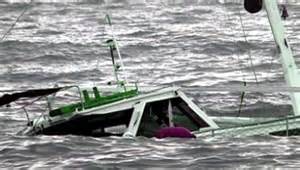
What You Do Next Can Mean The Difference Between Life And Death
Came across this article, and as always, a great read at any time of the season.
It’s your worst nightmare. A fitting may have failed; perhaps you struck a deadhead; maybe you stuffed a wave, or chopped the throttles to avoid a collision, bringing aboard tons of green water. You are taking on water faster than the pumps can evacuate it. What do you do now?
Here are seven steps that form the basis of an action plan. They are ordered by priority, but if you have able and responsible crew that you trust, assign them to handle some of the tasks so things get done simultaneously. Time is of the essence.
Order crew to don life jackets. Also, grab the ditch bag that you assembled with key items like a personal locator beacon, waterproof handheld VHF and signal flares.
Order crew to don life jackets. Also, grab the ditch bag that you assembled with key items like a personal locator beacon, waterproof handheld VHF and signal flares.
Make a mayday call. Hail the Coast Guard on VHF Channel 16, providing your location, the number of souls aboard and the nature of your distress. Wait 10 seconds for a reply before repeating.
Find the leak. If a hose has burst, you may be able to close its seacock. You can also jam wadded clothing into a rudder, prop-shaft hole or crack in the hull. Wedge the wad with whatever is available — knives, fishing rod butts, etc.
Use crash pumps. Inboard and sterndrive owners may be able to disconnect the engine’s raw-water intake hose and use the engine as a crash pump. Drop it in the bilge and get a crew member to monitor the water level: As it drops, throttle back so as not to run dry and overheat. Some boats are fitted with so-called “safety seacock” adaptors, like Groco’s SSC series that provide a valve enabling you to switch between engine intake and bilge at will.
Trim to slow the flow. If the leak is on the starboard side, shift crew and gear to port. Even if the hole doesn’t clear the water, moving it higher slows the flow.
Head for shore. Intentionally grounding on a bar or beach may be better than sinking, if you can avoid jagged rocks or high surf.
Stay with the boat. Many boats will float capsized and make a bigger target for a helicopter. Climb aboard to stave off exposure.
Have a plan in place.